
Laser IEC/EN 60825 Testing Laboratory
Laser projection display technology offers high brightness and wide color gamut, enhancing visual enjoyment. However, due to the narrow wavelength and concentrated energy characteristics of lasers, they may pose potential health risks to human eyes and skin. To address this, the International Electrotechnical Commission (IEC) updated and developed the laser safety classification standard iec 60825 Edition 3.0 (Safety of Laser Products – Part 1: Equipment Classification and Requirements), officially released in May 2014.

Laser IEC/EN 60825 Testing Standard
IEC/EN 60825 is a testing standard recognized by the European Union for laser classification. The definition of the IEC/EN 60825-1 standard is as follows:
1. Laser products near laser radiation must not exceed Class 1 Accessible Emission Limits (AEL) for the corresponding wavelength and emission duration (see Sections 8.2 and 8.4e).
2. Class 1M laser products have wavelengths in the range of 302.5 nm to 4000 nm. For the corresponding wavelength and emission duration (see Section 8.4e), personnel near laser radiation are not allowed to exceed Class 1 AEL. Radiation levels are measuRED according to Section 9.2g but must be lower than that of Class 1 laser products when using smaller apertures or when the apparent source is distant.
The IEC standard is developed by the International Electrotechnical Commission, a global standardization organization composed of various national electrotechnical committees. Its goal is to promote standardization in the field of electrical and electronic technologies worldwide.
Testing Methods for Laser Product IEC 60825 Safety Standards
1. Low-Intensity Light Sources:
If the light intensity is low (e.g., commonly used LEDs for displays or signaling), most products meet the requirements of IEC/EN 60825-1 Class 1, and testing is not necessary. When assessing, remove covers, optical, or similar components by hand. Reports shoULd state that the light intensity meets Class 1 laser requirements as defined by IEC/EN 60825-1.
2. Manufacturer Declarations:
For other cases, lighting equipment manufacturers should provide declarations (e.g., from LED manufacturers) based on relevant tests indicating that LED modules do not exceed Class 1 or Class 1M emission limits as per IEC/EN 60825-1. Reports should specify that judgments are based on manufacturer declarations.
3. Testing When Uncertain:
If no declaration is available or it is unclear how to judge compliance, testing should follow IEC/EN 60825-1 standards. Reports should indicate that measurements were performed. For lighting equipment with two types of laser sources, the testing report should detail compliance.
China JJR Institution – Laser IEC/EN 60825 Testing Laboratory
The JJR Institution in China is a qualified laser IEC/EN 60825 testing laboratory. It conducts relevant tests, issues test reports, and assists your laser products in gaining access to the European Union market. Our laboratory, located in China, can help you save up to 40% on testing costs.
Email:hello@jjrlab.com
Write your message here and send it to us
 WEEE Registration for Waste Electrical &Electr
WEEE Registration for Waste Electrical &Electr
 MSDS Chemical Safety Testing
MSDS Chemical Safety Testing
 What Are the Differences Between UK REACH and EU R
What Are the Differences Between UK REACH and EU R
 E-Cigarette GB 41700 Compliance Testing
E-Cigarette GB 41700 Compliance Testing
 What Are the Testing Items of California Propositi
What Are the Testing Items of California Propositi
 E-Cigarette EU TPD Testing
E-Cigarette EU TPD Testing
 Testing Certification for E-cigarettes Exported to
Testing Certification for E-cigarettes Exported to
 What is Amazon US CPC Certification?
What is Amazon US CPC Certification?
Leave us a message
24-hour online customer service at any time to respond, so that you worry!




